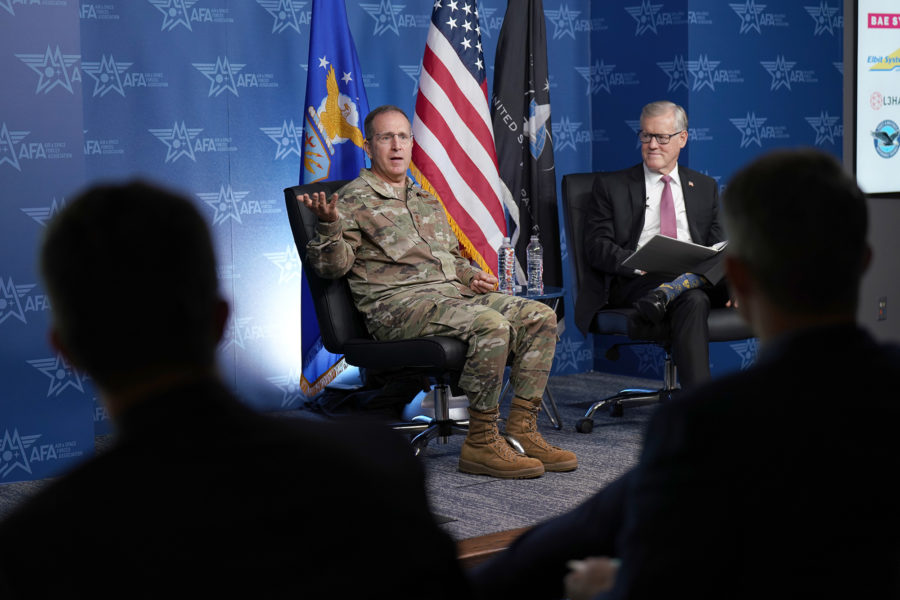Air Force Special Operations Command boss Lt. Gen. James C. “Jim” Slife extolled the benefits of the service’s new force generation and deployment model when it comes to explaining and managing risk for AFSOC—and warned against the dangers of centralization for the same reason.
Speaking at an AFA Warfighters in Action event Sept. 7, Slife argued that risk is often a forgotten element in the balancing act between mission requirements and resources.
“If you tell me, ‘Hey, Jim, I need you to do more mission with no more resources,’ I can do that. It just comes with increased risk, right?” Slife said. “Or if you tell me, ‘You’re taking too much risk. I need you to reduce the level of risk you’re taking,’ I can do that. It either means I do less mission or I need more resources. So I mean, there’s a three-way relationship here, and what we have to be better at is articulating risk in ways that are understandable to people outside the bubble of the Air and Space Forces.”
Force Generation
That challenge of articulating risk is of particular importance when it comes to deployments, Slife said.
The Air Force has implemented a new force generation model in recent years centered on four six-month cycles—“available to commit,” “reset,” “prepare,” and “ready.” After years of heavy deployment tempos in the Middle East, the new model gives Airmen and their families more predictability, leaders said.
But the system isn’t just better for the average Airman, Slife said. It’s also useful for commanders who want to look after their people while getting the mission done.
There’s tension between mission risk and resources.
“When I was an ops group commander, we were kind of in the … ‘more ISR, more ISR, more ISR’ business, and we had a couple of squadrons of MQ-1s and MQ-9s. And the question was always, ‘Hey, can you fly one more combat line for us?’ Slife said. “And how do you answer that question? I actually have a crew here that’s available. And I actually have an airplane that’s available, and I have a ground control station. And so, I mean, the answer is, ‘Yes, I can.’ But what I’m unable to communicate is the pressure on the force, right? I’m unable to communicate … the risk or the opportunity cost.”
With more clearly defined cycles, communicating those costs has become easier.
“We’ve been unable to talk about our capacity in a way that resonates with the Joint Force. It becomes too technical and complicated. And so when we migrated to a four-cycle force generation model, it allows us to have these conversations very unemotionally and very fact-based and allows us to articulate risk and capacity in a way that has really eluded us,” Slife said.
As an example, Slife cited last summer’s Afghanistan evacuation. As Kabul fell to the Taliban and the U.S. raced to evacuate Americans and threatened Afghans, Pentagon and U.S. Central Command leaders turned to AFSOC to provide AC-130J gunships to protect the forces and the aircraft flying in and out.
Using the force generation model, Slife explained that he could surge capacity, but that it would change the deployment cycles for Airmen and have effects on their schedules down the line. Leaders agreed to accept those effects.
“So we sent some more gunships to Afghanistan last summer. Two of those crews won the Mackay Trophy last year, did fantastic work,” Slife said. “But the key thing is, in October of last year, for the first time in 20 years, there were no gunships in CENTCOM.”
‘Jihad’ on Centralization
Mission requirements aren’t the only drivers of risk, though. A lack of resources can also cause issues, and Slife has no interest in trying to hide those gaps.
“I’m really on a kind of a jihad here against centralization inside of AFSOC—one of the evils of centralization is it masks your shortages,” Slife said.
When the Air Force or major commands consolidate all of one capability into one unit, it may seem that there is enough capacity to go around, Slife said. But when “maximum effort and deploying” are required, the shortfall becomes clear.
Instead of organizing units around capabilities, Slife wants to organize around mission sets, which “[highlights] the shortages we have,” he said.
In particular, Slife highlighted tactical communications equipment as an area where AFSOC needs to spend more.
“While we have had enough to operate out of fixed bases, where there’s already infrastructure in place, and all you’ve got to do is plug in, all the equipment’s already there, that’s not what the future environment looks like,” Slife said. “And so what we’re realizing is we’ve got some significant investments that we need to make in tactical communications, and I would tell you kind of the key area that we’re looking for there is software-defined capabilities.”
Slife’s focus on communications outside of fixed bases is in line with the Air Force’s embrace of agile combat employment, the operating concept whereby small teams of Airmen operate in remote or austere environments and move quickly.
Indeed, AFSOC has combined the concepts of ACE with mission-oriented units in its Mission Sustainment Teams, groups of Airmen with different speciality codes who can support themselves and other units anywhere in the field.
The MSTs have quickly become “in demand across our force,” Slife said. “Everybody wants to deploy with their own mission sustainment team. It’s pretty interesting.”
